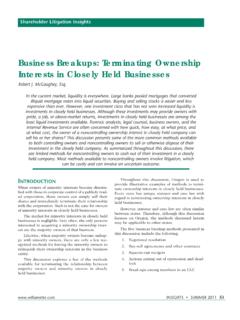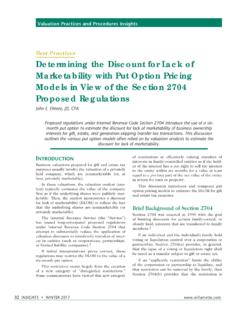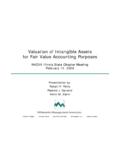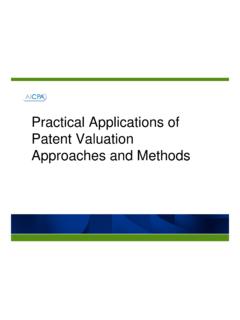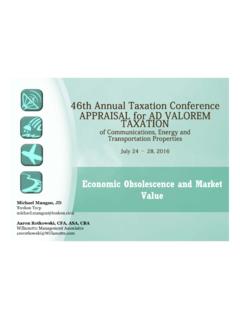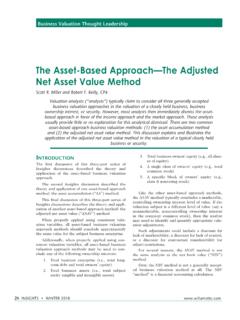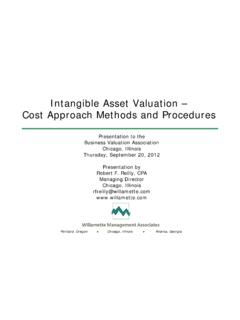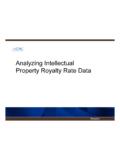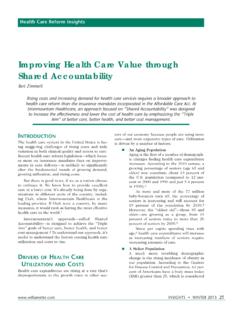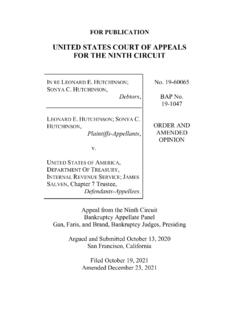Transcription of NOL Carryforward Use Limitation After the Ownership …
1 Www .willamette .com INSIGHTS WINTER 2011 79 NOL Carryforward Use Limitation After the Ownership Change of a Multiple Stock Class CorporationRobert F. Reilly, CPAI ncome Tax Insights In recent years, many taxpayer corporations have accumulated net operating loss (NOL) Carryforward income tax benefits. internal Revenue Code Section 382 limits the taxpayer corporation s use of the NOL tax benefit when there is a change of Ownership . Some change in Ownership transactions ( , mergers and acquisitions) are obvious. Other change in Ownership transaction ( , private equity investments, debt private placements with equity conversion features) are less obvious. This discussion summarizes some of the current valuation rules related to an Ownership change in NOL corporations that have multiple classes of stock industrial and commercial companies have been affected by the current economic recession.
2 Due to the impact of this prolonged recession, many taxpayer corporations have incurred a net operat-ing loss (NOL) for federal income tax purposes. For purposes of this discussion, such a taxpayer corpo-ration (whether closely held or publicly traded) is referred to as an NOL corporation. Many of these NOL corporations have also had to raise new debt or equity capital in order to survive during the prolonged capital formations may include (1) the pri-vate sale or public offering of common or preferred stock or (2) the issuance of debt instruments with some type of an equity feature (such as a stock war-rant or an equity conversion feature).An NOL is typically considered to be a federal income tax benefit to a taxpayer corporation.
3 This is because the NOL can be used by the taxpayer cor-poration to offset federal taxable income in future years (presumably when the economy improves and the subject company once again earns taxable income).Accordingly, this tax benefit is considered to be the taxpayer corporation s ability to use the NOL to offset future taxable income. This tax benefit is called an NOL Carryforward . However, After an Ownership change, internal Revenue Code Section 382 limits the amount of income that the NOL corporation may offset by the use of its pre-change NOL annual income offset Limitation is generally equal to an amount determined by multiplying (1) the fair market value of the taxpayer corporation equity by (2) the federal long-term tax-exempt rate in effect on the Ownership change Ownership changE can limit thE usE oF an nol carryForwardTwo kinds of taxpayer corporation Ownership chang-es can trigger the Section 382 NOL income offset Limitation :1.
4 An Ownership change involving a five per-cent shareholder80 INSIGHTS WINTER 2011 www .willamette .com2. any tax-free reorganization of the corpora-tion (with a few exceptions)In either case, a five percent shareholder must have increased his or her Ownership percentage in the NOL corporation by more than 50 percent (over his or her lowest pre-change Ownership percentage) within three years of the Ownership change second kind of NOL Limitation Ownership change event is usually more obvious. If the stock of the NOL corporation is merged or acquired in a tax-free transaction structure ( , a cash for stock purchase, a stock for stock exchange, etc.)
5 , then the Section 382 NOL Limitation first type of NOL Limitation Ownership change event is not always so obvious. For example, an Ownership change triggering event could include the private placement (or the public offering) of a relatively small amount of equity, an equity invest-ment by a private equity fund, the exercise of stock options by the taxpayer corporation employees, or other similar public or private capital placements may result in a Section 382 Ownership change in the NOL corporation. And, the Section 382 determina-tion of an Ownership change by a five percent shareholder is typically based on a valuation calcu-lation, as discussed After a capital formation event, the NOL corporation may have several classes of stock outstanding (voting and nonvoting stock; common and preferred stock; class A and class B common stock; etc.)
6 For an NOL corporation with multiple classes of stock outstanding, any price fluctuation in the stock trading price (for a public corporation) or in the stock fair market value (for a closely held corporation) will complicate the determination of whether the future use of the NOL Carryforward may be stock class nol corporationsSection 382(l)(3)(C) specifically addresses the issue of fluctuations in stock price/value (depending on whether the stock is public or private) for an NOL corporation with multiple classes of stock 382(l)(3)(C) states: Except as provided in regulations, any change in proportionate owner-ship which is attributable solely to fluctuations in the relative fair market values of different classes of stock shall not be taken into account.
7 However, the regulations do not specifical-ly address how to apply Section 382(l)(3)(C). Therefore, the multi-stock class NOL corporation (and its tax and valuation advisers) have little pro-fessional guidance related to a valuation issue that directly affects the taxpayer corporation s ability to use its prior years, the internal Revenue Service indi-cated its position on this change of Ownership issue through the issuance of private letter rulings. Most recently, the Service issued Notice 2010-50 regarding the NOL Limitation related to a change of corporate Ownership for a taxpayer corporation with multiple stock guidancE on sEction 382(l)(3)(c)Since 2004, the Service issued a series of letter rul-ings that have addressed the application of Section 382(l)(3)(C).
8 The earlier letter rulings generally indicated that: on any testing date, in determining the own-ership percentage of any 5% shareholder, the value of such shareholder s stock, relative to the value of all other stock of a loss corporation issued subse-quent to such acquisition date shall also be consid-ered to remain constant since the acquisition date. In the more recent letter rulings ( , Letter Rulings 201017004, 200952004, and 200901003), the Service adopted a valuation procedure that is www .willamette .com INSIGHTS WINTER 2011 81commonly referred to as the hold constant principle (HCP).For example, in Letter Ruling 201017004, the Service concluded that the [t]axpayer may apply a method employing the Hold Constant Principle to determine the increase in percentage Ownership of each of its 5% shareholders on each of its testing dates.
9 For purposes of Section 382. A comprehensive explanation of the NOL use limitations due to a change of Ownership in a mul-tiple stock class corporation is beyond the scope of this , (1) the application of the HCP and (2) the current internal Revenue Service interpretation of Section 382(l)(3)(C) as outlined in Notice 2010-50 are discussed rEvEnuE sErvicE noticE 2010-50 Recently, the Service provided Section 382(l)(3)(C) interim guidance to multiple stock class NOL corporations with the issuance of Notice 2010-50. This Notice appears to be the first guidance from the Service that actually provides specific application guidance for Section 382(l)(3)(C).
10 In particular, this Notice describes the accept-able valuation methods to account for any fluctua-tions in the value of one class of the NOL corpo-ration stock relative to another class of the NOL corporation stock for the purpose of determining the Section 382 NOL the Notice, the Service states that it will accept certain valuation methods for taking into account, or for not taking into account, any fluctua-tion in the NOL corporation stock summarized below, the Notice describes two valuation methods that the Service will accept in the application of Section 382(l)(3)(C) to quantify the NOL Limitation for a multiple stock class two valuation methods are called:1.
